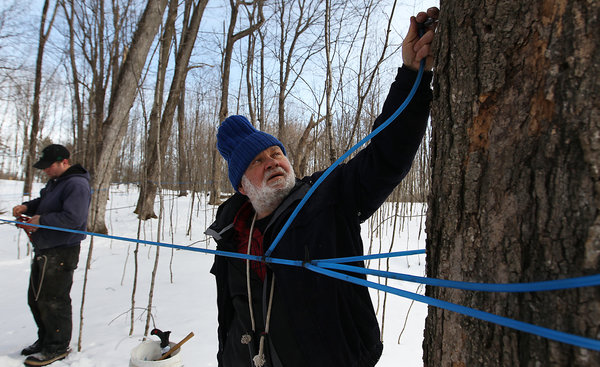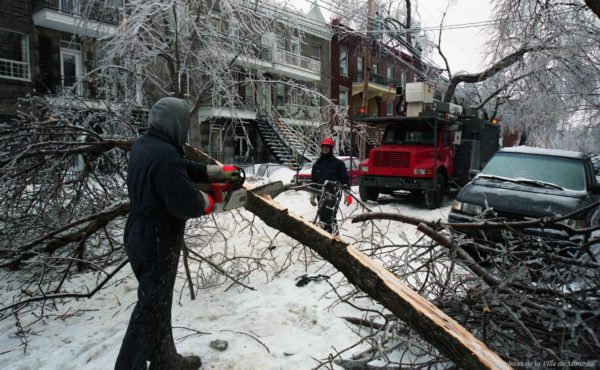
Archive for March, 2025
Maple syrup takes turn toward technology
Monday, March 31st, 2025
EAST MONTPELIER, Vt. — The rich, sweet tang of sap being boiled into maple syrup greeted tourists at Burr Morse’s sugar shack here this month — along with Mr. Morse, every inch the rural maple farmer in worn baseball cap and syrup-stained jacket, stirring the steaming evaporator with an old-fashioned dipper.
“People want to have a nostalgia trip,” said Mr. Morse, 65, a seventh-generation maple syrup farmer and the patriarch of Morse Farm Maple Sugarworks. “They want to see something natural, like taking sap from a tree.”

Forty years ago, Mr. Morse would snowshoe into the forest with his father to collect sap from galvanized buckets and load them onto a tractor. The farm has not changed much since then, but the winters have. So has the maple syrup ritual itself.
Scientists say the tapping season — the narrow window of freezing nights and daytime temperatures over 40 degrees needed to convert starch to sugar and get sap flowing — is on average five days shorter than it was 50 years ago. But technology developed over the past decade and improved in recent years offers maple farmers like Mr. Morse a way to offset the effects of climate change with high-tech tactics that are far from natural.
Today, five miles of pressurized blue tubing spider webs down the hillside at Morse Farm, pulling sap from thousands of trees and spitting it into tubs like an immense, inverse IV machine. Modern vacuum pumps are powerful enough to suck the air out of a stainless steel dairy tank and implode it, and they help producers pull in twice as much sap as before.
“You can make it run when nature wouldn’t have it run,” Mr. Morse said.
His greatest secret weapon is a reverse-osmosis machine that concentrates the sap by pulling it through sensitive membranes, greatly increasing the sugar content before it even hits the boiler. The $8,000 instrument with buttons and dials looks like it belongs in a Jetsons-era laboratory more than in a Vermont sugarhouse. But it saves more fuel and money than every other innovation combined. With it Mr. Morse can process sap into syrup in 30 minutes, something that used to take two hours.
Scientists project that climate change will eventually make New England less suitable for maple forests, but that the trees will continue to thrive in Canada, which even now produces more than 80 percent of the world’s maple syrup.
So an increasing number of maple producers are betting on technology.
The biggest United States maple farmers have expanded their production acreage and are tapping more trees than ever before: the total was 5.5 million taps last year, compared with slightly over 4 million taps 10 years earlier.
As a result, United States maple syrup production hit a new high in 2011. In Vermont, the top-producing state, sap yield per tap has risen over the past decade.
Maple farms are installing equipment that may take 10 years to earn back their cost in syrup sales.
“Technology has greatly increased that ability to make a full-time living,” said Matthew Gordon, the executive director of the Vermont Maple Sugar Makers Association. “It’s not merely the supplemental income it once was.”
But these changes have drawn questions about sustainability. Purists criticize the “techno-syrup” trend, saying it alters syrup’s rustic flavor and sucks the life out of maple trees.
Wrong on both counts, says Timothy Perkins, a plant biologist who directs the Proctor Maple Research Center in Underhill, Vt., the world’s foremost academic center for the study of maple and maple syrup.
“It’s pretty darn hard to kill a tree by over-tapping it — we’ve tried,” said Dr. Perkins, leading a tour through the center, past long counters with beakers, microscopes and segments of maple, as well as vacuum gauges, spouts and pliers.
The center’s scientists, who are employed by the University of Vermont, have altered the face of the industry many times over with inventions to make sugaring more efficient and sanitary, including a special plastic spout that prevents tap holes from drying up or collecting bacteria.
The center’s studies have found that as long as maple farmers follow tapping guidelines, maple trees can supply much more sap than was previously thought.
“It’s like the tree is a sugar-filled straw, with water and sap that we’re sucking right out of the ground,” Dr. Perkins said. “The amount we can get out of the soil is unlimited, but the amount of sugar in the tree is limited.”
As for taste, a chemical analysis of maple syrup processed with and without reverse osmosis concluded that some flavor compounds had been affected. But when the Proctor center conducted a sensory evaluation with a panel of top maple syrup tasters, no one could tell the difference. Dr. Perkins estimates that as much as 90 percent of the syrup now sold passes through reverse osmosis, adding a new dimension to the official “state flavor” of Vermont.
Dr. Perkins believes that a few more technical improvements could slightly lengthen the maple season, which usually ends in early April. Eventually, though, tubing and vacuums will not be able to overcome the effects of winters with too few extended cold snaps. Weather that is too warm can give late-season sap a “buddy” flavor — a taste that has been compared to sweaty gym socks.
Mr. Morse keeps a couple of “pet buckets” — old-fashioned metal ones — on maple trees to show tourists how it used to be done. He also burns wood chips instead of oil to power the evaporator, his only other concession to the past.
“It keeps our image intact,” he said.
Tags: climate change, maple syrup
Posted in Feature | No Comments »
Letter of Recommendation: Candle Hour
Tuesday, March 18th, 2025
One of my best teenage memories starts with a natural disaster. In January 1998, my parents and I returned to our home in Montreal to find that a giant tree limb had ruptured our living room. What would soon be known as the Great Quebec Ice Storm had struck. It was the most catastrophic in modern Canadian history. Accumulations of freezing rain had cracked our maple tree nearly in half. It shattered our front window, glass fringing the tree limb like a body outline in a murder scene.
Outside, downed power lines sparked like electric snakes. More than a million Quebecers were left without power. Cars were crushed and impaled by fallen limbs. Because the ice could inflict violence at any moment, everyone retreated indoors, making for an oddly quiet state of emergency. Except for the distant beeps of electrical-crew trucks, all you could hear was the crack of trees buckling under the weight of the ice, day and night. Long after the sidewalks were cleared, we tiptoed past the eaves of tall buildings and kept our voices low, steering clear of icicles thick as baseball bats and sharp as spikes, primed to fall at any moment.
For seven days and seven nights, until the power returned, we lived by candlelight. We learned to be mindful of candles: how to stand them up, walk with them, nurture their light. At first it was maddening to cook dinner — to carefully carry a plate of candles to the cupboard, poke around for ingredients, then go off again in search of a knife, taking care not to drip wax into the cutlery drawer. I learned how to brush my teeth and bathe by candlelight; the light bounced off the mirrors, making the bathroom for once the brightest room in the house. In our bedrooms, we piled under blankets and read ourselves to sleep by the flickering flames.
Outside, our neighborhood descended into darkness at twilight, but if I stared hard enough at windows blurred with ice, I could just make out little dancing lights. Decades later, no one in my family remembers what we talked about, or ate, or how we spent our afternoons that week. But we all remember the candles.

The Montreal Ice Storm, 1998. (Archives de Montreal)
I’ve since settled in California, and last January events in the world left me with a hunger for silence. I adopted a strict information diet: no television news or social media. One evening, I didn’t even bother to flick on the lights in my apartment. I walked quietly to the window and watched the last of the day, the darkness swallowing the trees along my street. Instinctively, I went looking for a book of matches in the back of the kitchen junk drawer. Opening a closet, I felt around until I discovered the remnant of a housewarming gift: a milk-white candle. I struck a match and lit the dusty wick. I commandeered a plate from the cupboard and set it on my coffee table. I nestled in a blanket, listening to the wind in the courtyard. Eventually, for the first time in too many days, I found myself surrendering to sleep.
That was the start of a practice I’ve taken to calling Candle Hour. An hour before I go to bed, I turn off all my devices for the night. I hit the lights. I light a candle or two or three — enough to read a book by, or to just sit and stare at the flame, which, by drawing oxygen, reminds me I need to breathe, too. I surround myself with scents and objects I like — some fresh rosemary plucked from a neighbor’s bush, a jar of redwood seed pods. I have a journal ready, but I don’t pressure myself to write in it. Candle Hour doesn’t even need to last a full hour, though; sometimes it lasts far longer. I sit until I feel an uncoupling from the chaos, or until the candle burns all the way down, or sometimes both.
Candle Hour has become a soul-level bulwark against so many different kinds of darkness. I feel myself slipping not just out of my day but out of time itself. I shunt aside outrages and anxieties. I find the less conditional, more indomitable version of myself. It’s that version I send into my dreams.
At night, by candlelight, the world feels enduring, ancient and slow. To sit and stare at a candle is to drop through a portal to a time when firelight was the alpha and omega of our days. We are evolved for the task of living by candlelight and maladapted to living the way we live now. Studies have noted the disruptive effects of nighttime exposure to blue-spectrum light — the sort emanated by our devices — on the human circadian rhythm. The screens trick us into thinking we need to stay alert, because our brains register their wavelength as they would the approach of daylight. But light on the red end of the spectrum sends a much weaker signal. In the long era of fire and candlelight, our bodies were unconfused as they began to uncoil.
Tonight’s candlelight will cast the same glow on my Oakland walls as it did on my parents’ walls in Montreal in 1998. I’ll feel in my bones that the day has passed — as all days, even fearful ones, eventually do. The day’s last act is cast in flickering gold. I’ll watch the flame bob and let my mind wander, until I realize I’m sleepy. After a while, I’ll lean over and blow it out, ready now for darkness — where renewal begins.
Tags: Candle Hour, Julia Scott, Letter of Recommendation, New York Times Magazine, Queben ice storm
Posted in Front Page | No Comments »
© 2025 Julia Scott.